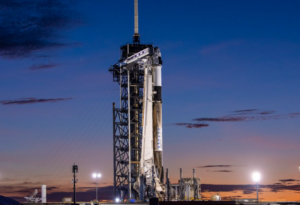Polaris Dawn Slips Again For a Different Kind of Weather Problem
SpaceX’s Polaris Dawn mission with four private astronauts just scrubbed again, the third night in a row. This time the problem is weather, but not the usual delay because of storms at the time of launch, but the forecast for the end of the mission.
Weather-related launch delays are routine especially at the launch pads along Florida’s Space Coast including Kennedy Space Center where the Polaris Dawn private astronaut mission will lift off.

What’s unusual this time is that the problem isn’t the weather at the scheduled launch time of 3:38 am tomorrow, August 28. Instead it’s the predicted weather on Monday when SpaceX’s Crew Dragon spacecraft would need to splash down either in the Atlantic Ocean or the Gulf of Mexico.
The launch initially was scheduled for Monday, August 26, at 3:38 am ET, but postponed to conduct additional pre-launch checkouts. Rescheduled for August 27 at the same time, a ground-side helium leak was detected and delayed again to August 28 at 3:38 am ET.
At 10:11 pm tonight (August 27), however, SpaceX tweeted that they would not launch either on August 28 or August 29 “due to unfavorable weather forecasted in Dragon’s splashdown areas off the coast of Florida.”

Ordinarily launch weather must be favorable up along the entire East Coast for human spaceflight launches into high inclination orbits like the one Polaris Dawn will use because the crew can abort and splashdown anywhere along that path, called the ascent corridor. In addition, SpaceX recovers the Falcon 9 rocket’s first stage on most of these flights, landing either on an autonomous drone ship at sea or back on land. Weather-related launch delays are not uncommon.
But Commander Jared Isaacman, the billionaire who is paying for the mission, explained that in this case they also have a limitation on how long they can remain in orbit so they must know the weather at the end of the mission also is favorable.
Isaacman and his three companions are not visiting the International Space Station. They are on their own mission, completely unrelated to NASA, with the goal to reach the highest altitude of any Earth-orbiting human spaceflight and then conduct the first commercial spacewalk.
Without the ISS as a safe haven full of supplies and consumables, like air, they can remain in space for only a fixed period. In this case, five days. They must know before they launch that the weather in the splashdown areas at that time will be favorable.
Our launch criteria are heavily constrained by forecasted splashdown weather conditions. With no ISS rendezvous and limited life support consumables, we must be absolutely sure of reentry weather before launching. As of now, conditions are not favorable tonight or tomorrow, so… https://t.co/Zpd3pY5kNF
— Jared Isaacman (@rookisaacman) August 28, 2024
Isaacman is an entrepreneur and experienced jet pilot. This will be his second spaceflight. The first, Inspiration4, lasted for three days and was the world’s first entirely commercial spaceflight. He then purchased three more SpaceX flights: two more Crew Dragons, of which this is the first, and the first crewed launch of SpaceX’s much larger Starship that’s still in development.
They are just some of the private astronaut missions taking place these days. SpaceX has launched three private astronaut missions to the ISS for Axiom Space and more are planned. Since they do visit the ISS, they can remain there if splashdown weather is unfavorable as has happened.
Polaris Dawn doesn’t have that luxury. Once they go up, they’ve got to come down before supplies run out.
Launching in Florida in the summertime is always a challenge and will be more so when weather has to be good not just one day, but five days later.
Isaacman said in his post on X:
“As Elon mentioned, Polaris Dawn is a challenging mission with critical objectives, so we’ll wait for the best opportunity to ensure success. Sometimes, the hardest journeys require the most patience, and we’re ready to wait for the right moment.”
SpaceX is planning another private astronaut flight that similarly will not visit the ISS. Called Fram2, it will be the first human spaceflight to circle Earth’s poles and last 3-5 days. The launch date has not been announced, only that it could be “as early as this year.”
User Comments
SpacePolicyOnline.com has the right (but not the obligation) to monitor the comments and to remove any materials it deems inappropriate. We do not post comments that include links to other websites since we have no control over that content nor can we verify the security of such links.